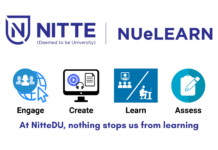Today, digital education is growing ever so fast, using the latest tools and technology for teaching and learning purposes. The use of software in the education sector is gaining popularity as Technology Enhanced Learning (TEL). It allows educators to engage with young learners effectively in a blended form of learning.
Technology has been penetrating the education system for quite some time. Modern classrooms are quite different from traditional classrooms. With newer technological advancements in the educational sector, both the students and the teacher have access to better resources to learn to their fullest potential. Digital platforms are primarily serving as a virtual learning room full of information and interactive lesson plans. The mesh of e-learning tools, reference applications, software updates, and modern multimedia has added a new layer to the educational process. The idea of incorporating software systems into the educational system is gradually becoming a staple in the academic world due to increased flexibility. And a broad spectrum of resources within arm’s reach is making this possible.
The integration of technology into the educational sector has revolutionized the ways of delivering and receiving information. Although the change has not been as drastic as experienced by other industries, educational institutions recognize the benefits associated with the implementation of software systems.
How Software Systems Aid Students in Learning
As educational software solutions’ efficacy increases, the scope of technology in the classrooms continues to grow. Implementing software systems will give teachers, students, parents, and administrators’ necessary tools to enhance learning efficiency in classrooms.
Here are several ways through which the software systems help students in learning.
Collaboration in the Classroom
The education software promotes significant collaboration between students and teachers. In particular, management software is designed to curb the distractions within classrooms. It creates avenues for students to collaborate regarding academic activities like assignments and tests. Students can learn about various fields and subjects from an early age due to technological tools in classrooms. They can understand the dynamics of an area, what it entails, and how it can benefit them. For instance, students can understand coding at an early age, thanks to tech solutions. These solutions, such as the hour of code activities, are laden with features that allow students to communicate and work on projects.
Moreover, the teacher has access to tools that can ensure collaboration among students and ensure that they stay on task throughout the lesson’s duration.
Student Engagement
Student engagement is an issue for educational professionals and students alike—specific software systems aid institutions in improving engagement levels. Technology like virtual reality software and augmented reality software significantly impacts the engagement levels among students and teachers. They also help students overcome problems lying within, for instance, curbing disengagement with learning material.
Another way through which technology increases student engagement is excitement to use a new form of learning. Imagine the wonder of second graders that get to put on VR headsets and dive into the world of visual learning. The elementary kids virtually strolling among ancient civilizations’ ruins for their history class will absorb way more than students learning only from textbooks.
Allows Information Retention
Technology is perhaps the best way of retaining information. Unless one is blessed with a photographic memory, knowledge retention can be quite a task that most students dread. Lessons, when coupled with an artificially intelligent tutor, allow the students to help evaluate many challenges. Artificial assistants can rearrange the assessment and content. They can also help students understand their areas of weakness and improve their knowledge in a particular subject.
Lighten Workloads
The software systems enhance the quality of education for students by lightening the workload on teachers and students. Educators cannot deliver lessons to students to their fullest potential while being troubled with unresolved workloads. These workloads can be creating, grading, and distributing assessments. However, with software systems, these tasks become more manageable. Moreover, with AI-powered grading tools, accurate grading of the written answers and MCQs has become more manageable. As the technology evolves, the glut of tools in an educator’s arsenal will only increase, consequently ensuring quality education delivery.
The potential of VR/AR solutions in achieving the status of being omnipresent in virtual classrooms is significantly influencing the engagement levels amongst students. Instructors can quickly identify the at-risk pupils in a particular area through the Student Information System (SIS). It helps them improve by carefully constructing a comprehensive strategy or giving them more attention.
Improve Communication between Students and Teachers
Effective communication is the key to good learning. It is a great benefit to be attributed to the educational software systems. The students’ capability to absorb knowledge depends significantly upon the teacher’s way of conveying the information. Software designed to curb the communication gap between the students and the teachers makes it easier for students to share their concerns with the teacher and the administration. Learning Management Software (LMS) is a type of solution that provides students and parents with a platform to access and communicate with the management without any barriers. Other such software includes Classroom Management Software (CMS) and Student Information Software (SIS).
Software systems help in overcoming the barriers in communication between the parents/guardians and institutional management. Implementing many accessible communication tools creates a medium between the parents and administration and allows them to voice their concerns. The technology serves to strengthen the bond between all parties involved in the learning process and eliminates the chances of miscommunication and ambiguity.
Conclusion
The future of education is digital, with the classrooms quite different from those we have today. The conventional education model consists of educators teaching students in physical classes, unable to manage everything simultaneously. Educational software systems operate with a blend of tech tools to address the most common issues that hinder quality education. It aims at making education exciting and smooth so that the students can learn in a flexible environment and get the most out of the textbooks. Although this phenomenon is growing in developed nations, there is still a lot to be done for developing countries.




![Merchant Navy Recruitment 2024: [4000+ Posts]: How To Apply Online? Merchant Navy Recruitment 2024: [4000+ Posts]: How To Apply Online?](https://futurewithtech.com/wp-content/uploads/2024/05/Indian-Merchant-Navy-Recruitment-2024-218x150.jpg)
